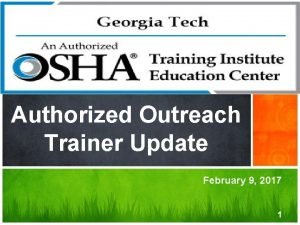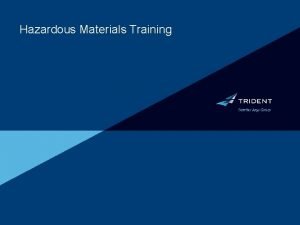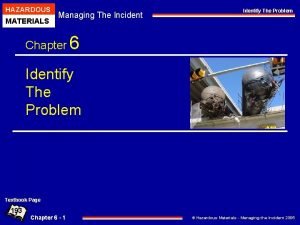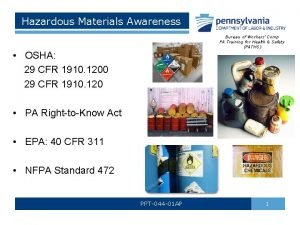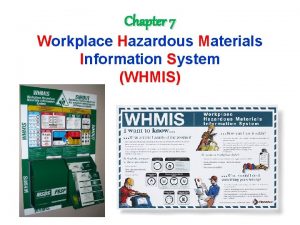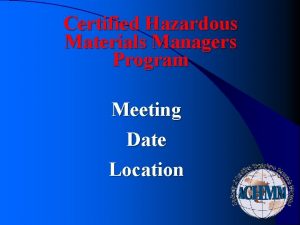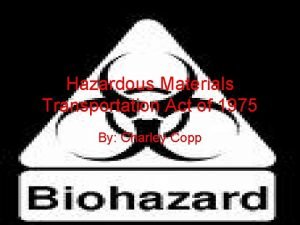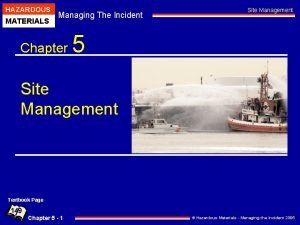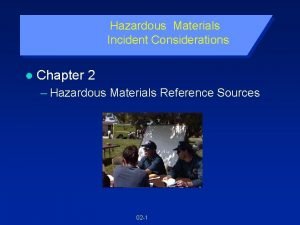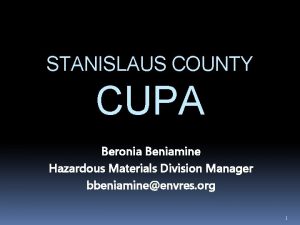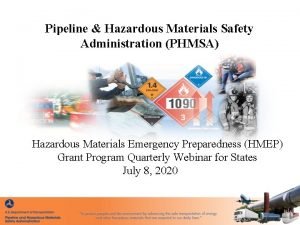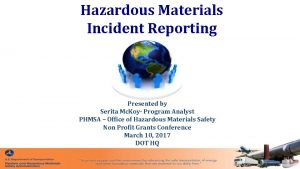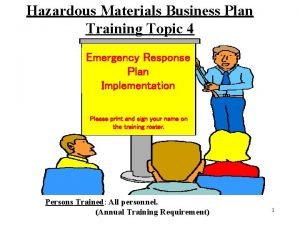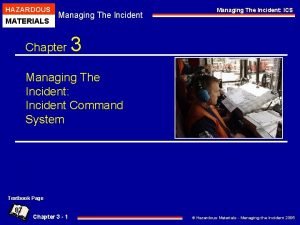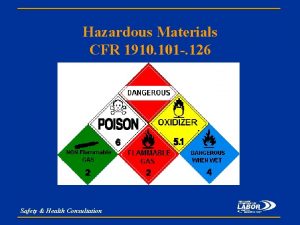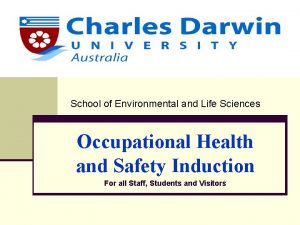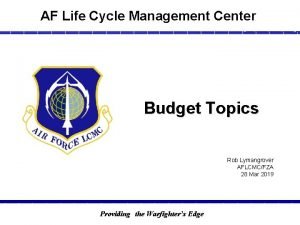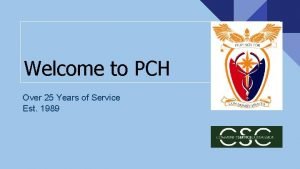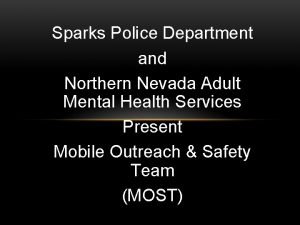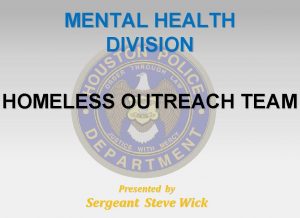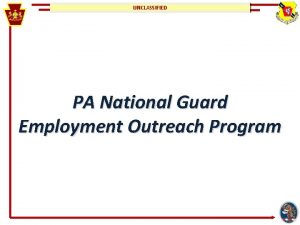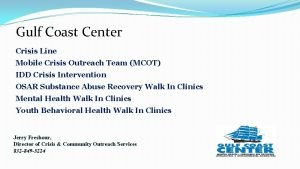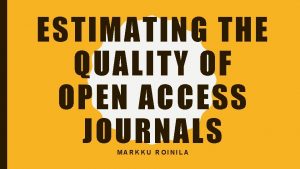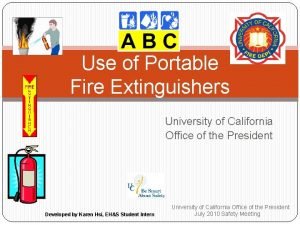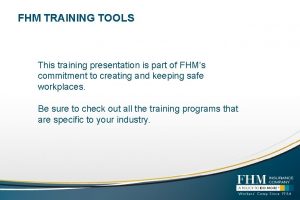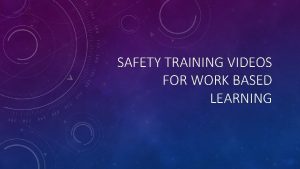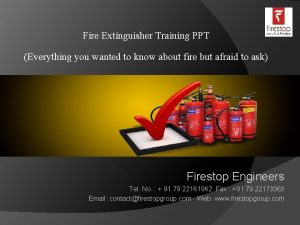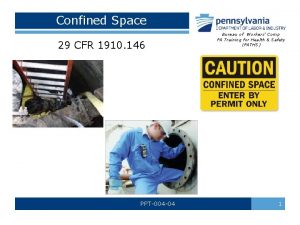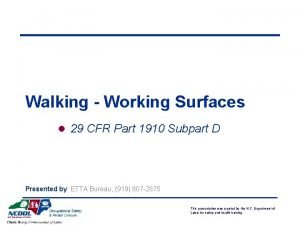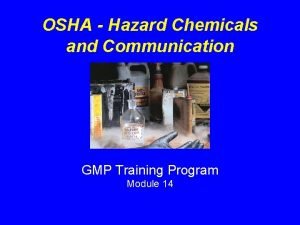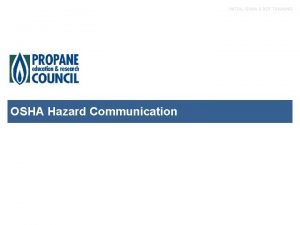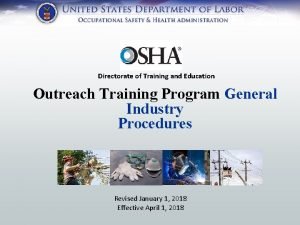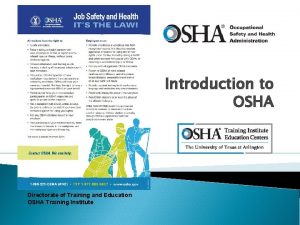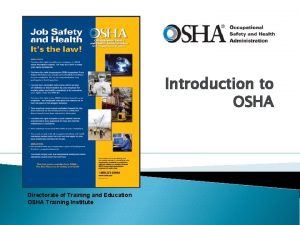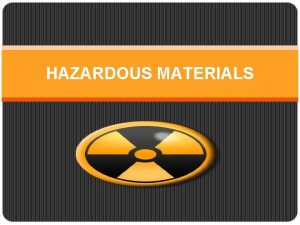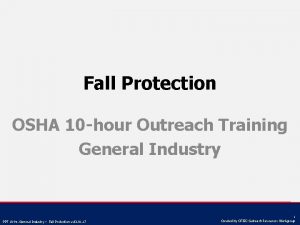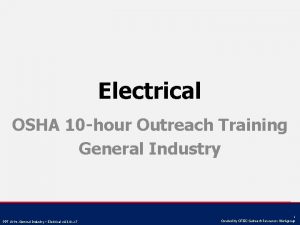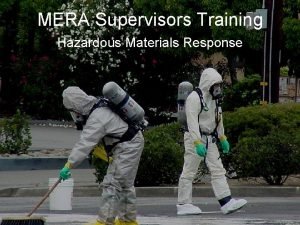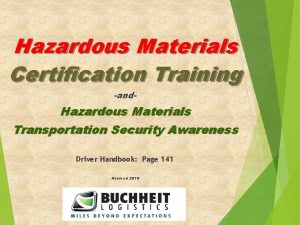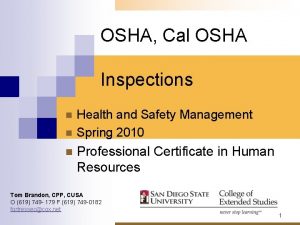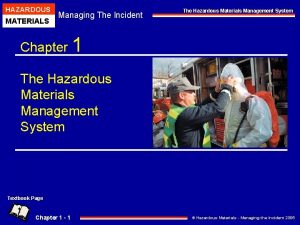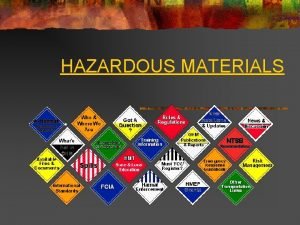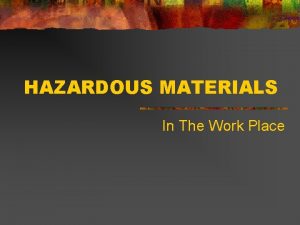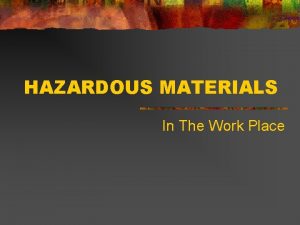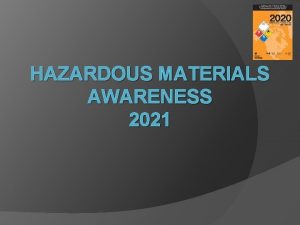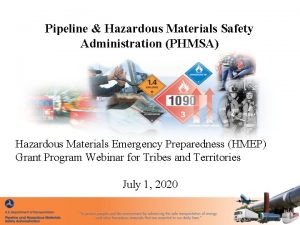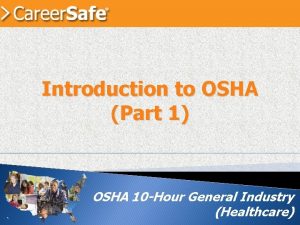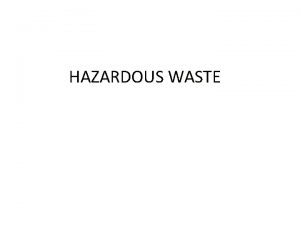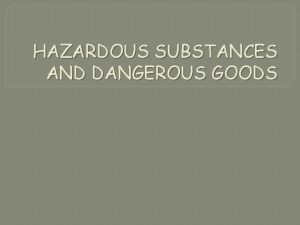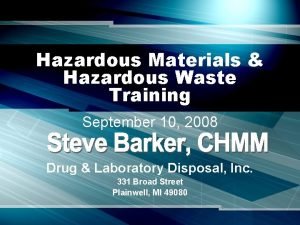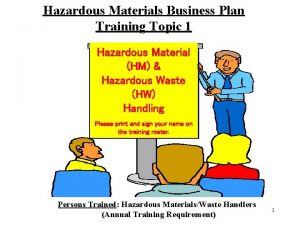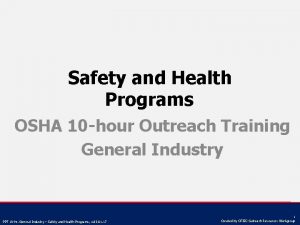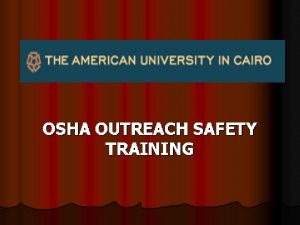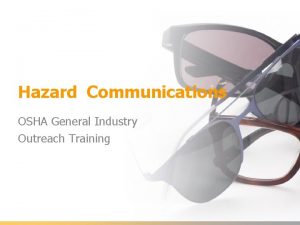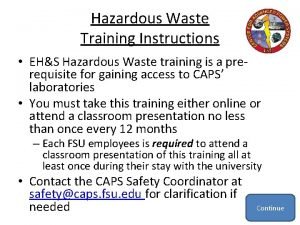Hazardous Materials OSHA 10 hour Outreach Training General

















































- Slides: 49

Hazardous Materials OSHA 10 -hour Outreach Training General Industry PPT 10 -hr. General Industry – Hazardous Materials v. 03. 01. 17 1 Created by OTIEC Outreach Resources Workgroup

Introduction Lesson objectives: 1. Identify types of hazardous materials and how exposures can occur. 2. Identify hazards associated with hazardous materials, including injuries that may occur. 3. Describe methods for eliminating physical hazards of hazardous materials. 4. Describe methods for eliminating health hazards of hazardous materials. PPT 10 -hr. General Industry – Hazardous Materials v. 03. 01. 17 2 Created by OTIEC Outreach Resources Workgroup

What’s in it for you? Source: Construction Safety Council, used with permission. PPT 10 -hr. General Industry – Hazardous Materials v. 03. 01. 17 3 Created by OTIEC Outreach Resources Workgroup

Exposure to Hazardous Materials What are hazardous materials? • Group of products for which the storage, handling, and use are regulated under the Hazardous Materials standard • Primarily associated with physical hazard • May also pose health hazard PPT 10 -hr. General Industry – Hazardous Materials v. 03. 01. 17 4 Created by OTIEC Outreach Resources Workgroup

Exposure to Hazardous Materials Examples of worksite exposure: • Operations involving the storage, handling, and/or use of: – Compressed gases • Liquefied gases – anhydrous ammonia, chlorine, propane, nitrous oxide, and carbon dioxide • Non-liquefied gases – oxygen, nitrogen, helium, and argon • Dissolved gases - acetylene PPT 10 -hr. General Industry – Hazardous Materials v. 03. 01. 17 5 Created by OTIEC Outreach Resources Workgroup

Exposure to Hazardous Materials – Flammable liquids • Category 1 – ethyl ether, isopentane, propylene oxide • Category 2 – acetone, benzene, ethyl alcohol, gasoline isopropyl alcohol, toluene • Category 3 – naphtha, turpentine, xylene • Category 4 – ethylene glycol, glycerine – Cryogenics and refrigerated liquids – oxygen, nitrogen, argon, hydrogen, helium LNG, Liquid methane, carbon monoxide – Liquefied petroleum gases (LPGs) – propane, propylene, butane, and butylene – Explosives and blasting agents PPT 10 -hr. General Industry – Hazardous Materials v. 03. 01. 17 6 Created by OTIEC Outreach Resources Workgroup

Exposure to Hazardous Materials • Spray finishing operations • Dipping and coating operations • Processing of highly hazardous chemicals • Clean-up and management of hazardous waste operations and emergency response Source: OSHA; courtesy of U. S. Air Force Source: FEMA; S. Shapira PPT 10 -hr. General Industry – Hazardous Materials v. 03. 01. 17 7 Created by OTIEC Outreach Resources Workgroup

Exposure to Hazardous Materials Additional precautions for hazard exposures: • Hazardous (classified) locations • Confined spaces Source: OSHA PPT 10 -hr. General Industry – Hazardous Materials v. 03. 01. 17 8 Created by OTIEC Outreach Resources Workgroup

Exposure to Hazardous Materials Routes of entry: • • Inhalation* Ingestion Absorption Injection * Most Common Source: Construction Safety Council, used with permission. PPT 10 -hr. General Industry – Hazardous Materials v. 03. 01. 17 9 Created by OTIEC Outreach Resources Workgroup

Hazards of Hazardous Materials Types of physical hazards associated with hazardous materials: • Oxidizer • Flammable • Explosion • Corrosive to metal • High-pressure systems Source of pictograms: OSHA PPT 10 -hr. General Industry – Hazardous Materials v. 03. 01. 17 10 Created by OTIEC Outreach Resources Workgroup

Hazards of Hazardous Materials Types of health hazards associated with hazardous materials: • Acute/chronic toxicity • Skin corrosion or irritation • Aspiration hazard • Serious eye damage or eye irritation • Respiratory or skin sensitization • • Germ cell mutagenicity Carcinogenicity Reproductive toxicity Specific target organ toxicity Source of pictograms: OSHA PPT 10 -hr. General Industry – Hazardous Materials v. 03. 01. 17 11 Created by OTIEC Outreach Resources Workgroup

Hazards of Hazardous Materials Compressed gases: • • • Oxygen displacement Fires Explosion Toxic gas exposures Physical hazards associated with high pressure systems PPT 10 -hr. General Industry – Hazardous Materials v. 03. 01. 17 Source: OSHA 12 Created by OTIEC Outreach Resources Workgroup

Hazards of Hazardous Materials Cryogenic and refrigerated liquids: • • Extreme cold Extreme pressure Asphyxiation Fire or explosion Source: OSHA PPT 10 -hr. General Industry – Hazardous Materials v. 03. 01. 17 13 Created by OTIEC Outreach Resources Workgroup

Hazards of Hazardous Materials Flammable liquids: • Fire • Explosion Source: OSHA Criteria for Flammable Liquids Category 29 CFR 1910. 1200 Appendix B, B. 6. 2 PPT 10 -hr. General Industry – Hazardous Materials v. 03. 01. 17 Criteria 1 Flashpoint < 73. 4°F and initial boiling point ≤ 95°F 2 Flashpoint < 73. 4°F and initial boiling point > 95°F 3 Flashpoint ≥ 73. 4°F and ≤ 140°F 4 Flashpoint > 140°F and ≤ 199. 4°F 14 Created by OTIEC Outreach Resources Workgroup

Hazards of Hazardous Materials Spray finishing: • Flammable/combustible materials • Health hazards • Example: Isocyanates – Powerful irritant to eyes and gastrointestinal and respiratory tracts – Inflammation to skin Source of photos: NIOSH PPT 10 -hr. General Industry – Hazardous Materials v. 03. 01. 17 15 Created by OTIEC Outreach Resources Workgroup

Hazards of Hazardous Materials Liquefied petroleum gases (LPG): • Pictograms: • Signal word: Danger • Hazard statements: – Extremely flammable gas. – Contains gas under pressure; may explode if heated. – May cause frostbite. – May form explosive mixtures in air. – May displace oxygen and cause rapid suffocation. Source: OSHA PPT 10 -hr. General Industry – Hazardous Materials v. 03. 01. 17 16 Created by OTIEC Outreach Resources Workgroup

Hazards of Hazardous Materials Anhydrous ammonia: • Pictograms: • Signal word: Danger • Hazard statements – – – Flammable Gas Contains gas under pressure May explode if heated Toxic if inhaled Causes severe skin burns and eye damage Corrosive to respiratory tract PPT 10 -hr. General Industry – Hazardous Materials v. 03. 01. 17 Source of photos: OSHA 17 Created by OTIEC Outreach Resources Workgroup

Hazards of Hazardous Materials Hazardous (classified) locations: • Class I – flammable gases or vapors – – • Class II – combustible dust – – • Division 1 Division 2 Class III – ignitable fibers or flyings PPT 10 -hr. General Industry – Hazardous Materials v. 03. 01. 17 18 Created by OTIEC Outreach Resources Workgroup

Hazards of Hazardous Materials Confined spaces: • Limited or restricted means for entry/exit; not designed for continuous occupancy • PRCS contains or has potential to contain hazardous atmospheres Source of photos: OSHA PPT 10 -hr. General Industry – Hazardous Materials v. 03. 01. 17 19 Created by OTIEC Outreach Resources Workgroup

Controlling Physical Hazards Source: NIOSH PPT 10 -hr. General Industry – Hazardous Materials v. 03. 01. 17 20 Created by OTIEC Outreach Resources Workgroup

Controlling Physical Hazards Compressed gases: • Compressed gas cylinders shall be in a safe condition to the extent that this can be determined by visual inspection. Source of graphics: OSHA PPT 10 -hr. General Industry – Hazardous Materials v. 03. 01. 17 21 Created by OTIEC Outreach Resources Workgroup

Controlling Physical Hazards Safety can: • Not more than 5 gallons capacity • Spring-closing lid • Designed to relieve internal pressure when subjected to fire. Source of photos: OSHA PPT 10 -hr. General Industry – Hazardous Materials v. 03. 01. 17 22 Created by OTIEC Outreach Resources Workgroup

Controlling Physical Hazards Cabinets: • Not more than 60 gallons of Category 1, 2, or 3 flammable liquids, nor more than 120 gallons of Category 4 flammable liquids. • Suitable fire control devices shall be available at locations where flammable liquids are stored. Source of photos: OSHA PPT 10 -hr. General Industry – Hazardous Materials v. 03. 01. 17 23 Created by OTIEC Outreach Resources Workgroup

Controlling Physical Hazards Ventilation: • Category 1 or 2 flammable liquids, or Category 3 flammable liquids with a flashpoint below 100 °F (37. 8 °C), shall be ventilated at a rate of not less than 1 cubic foot per minute per square foot of solid floor area. PPT 10 -hr. General Industry – Hazardous Materials v. 03. 01. 17 24 Created by OTIEC Outreach Resources Workgroup

Controlling Physical Hazards Explosion-proof apparatus: • Apparatus enclosed in a case that is capable of withstanding an explosion of a specified gas or vapor that may occur within it and of preventing the ignition of a specified gas or vapor surrounding the enclosure by sparks, flashes or explosion of the gas or vapor within, and that operates at such an external temperature that it will not ignite a surrounding flammable atmosphere. PPT 10 -hr. General Industry – Hazardous Materials v. 03. 01. 17 25 Created by OTIEC Outreach Resources Workgroup

Controlling Physical Hazards Grounding: • Category 1 or 2 flammable liquids, or Category 3 flammable liquids with a flashpoint below 100 °F (37. 8 °C), shall not be dispensed into containers unless the nozzle and container are electrically interconnected. Source of graphics: OSHA PPT 10 -hr. General Industry – Hazardous Materials v. 03. 01. 17 26 Created by OTIEC Outreach Resources Workgroup

Controlling Physical Hazards Intrinsically safe: • An apparatus/equipment in which all the circuits in which any spark or thermal effect is incapable of causing ignition of a mixture of flammable or combustible material in air. PPT 10 -hr. General Industry – Hazardous Materials v. 03. 01. 17 27 Created by OTIEC Outreach Resources Workgroup

Controlling Health Hazards Source: NIOSH PPT 10 -hr. General Industry – Hazardous Materials v. 03. 01. 17 28 Created by OTIEC Outreach Resources Workgroup

Controlling Health Hazards Source: OSHA PPT 10 -hr. General Industry – Hazardous Materials v. 03. 01. 17 29 Created by OTIEC Outreach Resources Workgroup

Controlling Health Hazards Source: NIOSH PPT 10 -hr. General Industry – Hazardous Materials v. 03. 01. 17 30 Created by OTIEC Outreach Resources Workgroup

Controlling Health Hazards Source: NIOSH PPT 10 -hr. General Industry – Hazardous Materials v. 03. 01. 17 31 Created by OTIEC Outreach Resources Workgroup

Controlling Health Hazards Source: NIOSH PPT 10 -hr. General Industry – Hazardous Materials v. 03. 01. 17 32 Created by OTIEC Outreach Resources Workgroup

Controlling Health Hazards Process Safety Management (PSM) of highly hazardous chemicals: • Regulations designed to prevent the release of toxic, reactive, flammable and/or explosive chemicals. • Contains a list and threshold limits for when employers must comply. – Anhydrous Ammonia - 10, 000 lbs – Chlorine - 1, 500 lbs PPT 10 -hr. General Industry – Hazardous Materials v. 03. 01. 17 33 Created by OTIEC Outreach Resources Workgroup

Controlling Health Hazards Hazardous Waste Operations and Emergency Response (HAZWOPER): • Applies to employers and their employees who are exposed to hazardous substances and who are engaged in several operations including clean-up, treatment, storage and disposal of hazardous waste. PPT 10 -hr. General Industry – Hazardous Materials v. 03. 01. 17 34 Created by OTIEC Outreach Resources Workgroup

Hazardous Materials Worksheet Complete the Worksheet PPT 10 -hr. General Industry – Hazardous Materials v. 03. 01. 17 35 Created by OTIEC Outreach Resources Workgroup

Hazardous Materials Worksheet Hazard Anticipation Source: Construction Safety Council, used with permission. PPT 10 -hr. General Industry – Hazardous Materials v. 03. 01. 17 36 Created by OTIEC Outreach Resources Workgroup

Hazardous Materials Worksheet Hazards Identification Source: Construction Safety Council, used with permission. PPT 10 -hr. General Industry – Hazardous Materials v. 03. 01. 17 37 Created by OTIEC Outreach Resources Workgroup

Hazardous Materials Worksheet Hazards Evaluation Source: Construction Safety Council, used with permission. PPT 10 -hr. General Industry – Hazardous Materials v. 03. 01. 17 38 Created by OTIEC Outreach Resources Workgroup

Hazardous Materials Worksheet Hazards Controls - Engineering Source: Construction Safety Council, used with permission. PPT 10 -hr. General Industry – Hazardous Materials v. 03. 01. 17 39 Created by OTIEC Outreach Resources Workgroup

Hazardous Materials Worksheet Hazards Controls - Administrative Source: Construction Safety Council, used with permission. PPT 10 -hr. General Industry – Hazardous Materials v. 03. 01. 17 40 Created by OTIEC Outreach Resources Workgroup

Hazardous Materials Worksheet Hazards Controls - PPE Source: Construction Safety Council, used with permission. PPT 10 -hr. General Industry – Hazardous Materials v. 03. 01. 17 41 Created by OTIEC Outreach Resources Workgroup

Summary Stop health hazards before they stop you! Source: Construction Safety Council, used with permission. PPT 10 -hr. General Industry – Hazardous Materials v. 03. 01. 17 42 Created by OTIEC Outreach Resources Workgroup

Knowledge Check 1. The most common route of entry by which hazardous materials are introduced into the body is ___. a. b. c. d. inhalation absorption ingestion injection Answer: a. inhalation PPT 10 -hr. General Industry – Hazardous Materials v. 03. 01. 17 43 Created by OTIEC Outreach Resources Workgroup

Knowledge Check 2. Flammability is which type of hazard? a. b. c. d. Carcinogenic Health Physical Mutagenic Answer: c. Physical PPT 10 -hr. General Industry – Hazardous Materials v. 03. 01. 17 44 Created by OTIEC Outreach Resources Workgroup

Knowledge Check 3. Which of the following hazards is an example of a physical hazard? a. b. c. d. Oxidizer Exposure to carcinogen Chronic toxicity Acute toxicity Answer: a. Oxidizer PPT 10 -hr. General Industry – Hazardous Materials v. 03. 01. 17 45 Created by OTIEC Outreach Resources Workgroup

Knowledge Check 4. Which of the following hazards is an example of a health hazard? a. b. c. d. Fire hazard Acute toxicity Explosive High pressure Answer: b. Acute toxicity PPT 10 -hr. General Industry – Hazardous Materials v. 03. 01. 17 46 Created by OTIEC Outreach Resources Workgroup

Knowledge Check 5. Which of the following is the preferred order of controlling hazards, or “hierarchy of controls, ” for hazardous materials? a. PPE, Administrative Controls, Engineering Controls, Elimination b. Administrative Controls, Engineering Controls, Elimination, PPE c. Engineering Controls, Elimination, PPE, Administrative Controls d. Elimination, Engineering Controls, Administrative Controls, PPE Answer: d. Elimination, Engineering Controls, Administrative Controls, PPE PPT 10 -hr. General Industry – Hazardous Materials v. 03. 01. 17 47 Created by OTIEC Outreach Resources Workgroup

Knowledge Check 6. When transferring a flammable liquid from one container to another, the containers should be ___ to prevent static electricity from creating a fire hazard. a. b. c. d. ventilated or pressurized ventilated and pressurized bonded or grounded bonded and grounded Answer: d. bonded and grounded PPT 10 -hr. General Industry – Hazardous Materials v. 03. 01. 17 48 Created by OTIEC Outreach Resources Workgroup

Knowledge Check 7. Which of the following hazard controls is an example of an engineering control? a. Enclosing an operation to prevent contact with the hazardous material b. Training employees on the proper handling and storage of a hazardous material c. Implementing a procedure for the proper use of a hazardous material d. Requiring personal protective equipment to be worn when working with a hazardous material Answer: a. Enclosing an operation to prevent contact with the hazardous material PPT 10 -hr. General Industry – Hazardous Materials v. 03. 01. 17 49 Created by OTIEC Outreach Resources Workgroup
 Georgia tech oti
Georgia tech oti Dot
Dot Hazardous materials table
Hazardous materials table Us military marking system for hazardous materials
Us military marking system for hazardous materials Hazwoper
Hazwoper Shape and color of whmis 2015 symbols
Shape and color of whmis 2015 symbols Isachmm
Isachmm Hazardous materials transportation act of 1975
Hazardous materials transportation act of 1975 Hazardous materials managing the incident
Hazardous materials managing the incident Hazardous materials reference books
Hazardous materials reference books Stanislaus county hazardous waste
Stanislaus county hazardous waste Pipeline and hazardous materials administration
Pipeline and hazardous materials administration Hazardous materials incident report
Hazardous materials incident report Hazardous materials business plan
Hazardous materials business plan Hazardous materials managing the incident
Hazardous materials managing the incident Compressed gas association pamphlet p-1-1965
Compressed gas association pamphlet p-1-1965 Hazardous area training darwin
Hazardous area training darwin Hand and power tool safety ppt
Hand and power tool safety ppt What is the time
What is the time Semester vs trimester
Semester vs trimester Theodora okiro
Theodora okiro Matlamat program
Matlamat program Drug outreach team belfast
Drug outreach team belfast Sam nelson outreach
Sam nelson outreach Nesac outreach facility
Nesac outreach facility Afman 65-605
Afman 65-605 Pch outreach program
Pch outreach program Sparks police report
Sparks police report Hpd homeless outreach team
Hpd homeless outreach team National collaborative outreach programme
National collaborative outreach programme Outreach program
Outreach program Phytel appointment reminder
Phytel appointment reminder Gulf coast center mental health
Gulf coast center mental health Research outreach predatory
Research outreach predatory Cires education and outreach
Cires education and outreach Community health education outreach programs
Community health education outreach programs Ladder safety training ppt
Ladder safety training ppt Cal osha fire extinguisher training
Cal osha fire extinguisher training Osha yard tractor training
Osha yard tractor training Youtube safety videos for workplace
Youtube safety videos for workplace Fire safety training ppt
Fire safety training ppt Confined space training ppt
Confined space training ppt 29 cfr part 1910
29 cfr part 1910 Osha hazard and ghs training regulation cfr 1910
Osha hazard and ghs training regulation cfr 1910 Osha hazard communication inital training
Osha hazard communication inital training Osha directorate of training and education
Osha directorate of training and education Osha directorate of training and education
Osha directorate of training and education Osha directorate of training and education
Osha directorate of training and education Personally identifiable information pii training 1 hour
Personally identifiable information pii training 1 hour Natural materials
Natural materials
